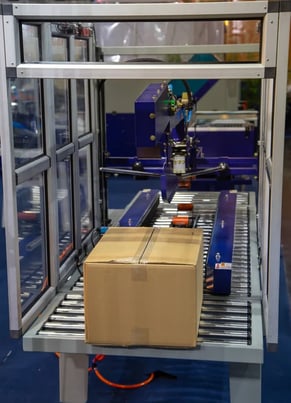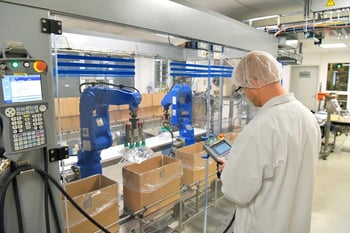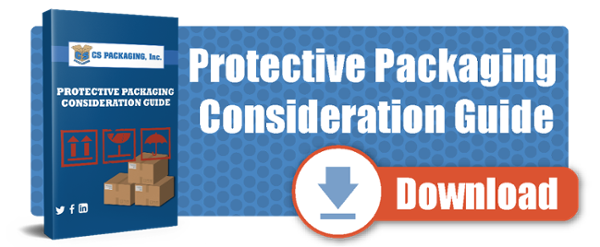It’s no secret: the global sales landscape is changing.

And with an uptick in eCommerce sales, paired with global labor and material shortages, manufacturers and distributors have been forced to “reshuffle” their workforces in order to maximize output while minimizing waste.
To help achieve this goal, many industries have begun adopting automation technology throughout their manufacturing processes to help alleviate labor needs while reducing potential waste from slow production speeds or downed lines.
And one of the main processes being automated across all industries is the packaging process.
With the use of specialized machinery, manufacturers, OEMs, and distributors are able to increase the efficiency and speed of the entire packaging process.
From carton erectors to void fill machinery, automated packaging lines promote sustainability by reducing waste (both material and labor), and increasing speed and efficiency.
This guide will help to determine the level of automation and which machines the best suit your packaging process.
Automated Packaging Solutions | Choosing the Right Equipment
Automated packaging solutions can come in many forms, and while some manufacturers invest in custom or proprietary machinery, there are 7 main, readily-available, types of automation equipment that can improve any packaging process. Those 7 include:
- Carton Sealers
- Automated Void Fill and Cushioning Machinery
- Case/Carton Erectors
- Stretch Film Machine
- Shrink Film Machine
- Strapping and Banding Machines
- Automated Poly Bagging Systems (Auto-baggers)
7 Main Types of Automated Packing Machines:
1. Carton Sealers- Tape machine that tapes either the bottom of the box, the top, or both
- These machines can be purchased as manual or automatic, and the features depend on the level of customization needed. Some are for very basic applications, (such as the same carton going through repeatedly), while some use fully automatic and pneumatic systems to integrate into automated packaging lines for all different box sizes
2. Automated Void Fill and cushioning machinery
- These machines convert a flat substrate into the shape you need for void fill, cushioning, wrapping, or blocking and bracing
- These come in all different types such as paper converters and air pillow machines
These machines are versatile when it comes to sustainability. They dispense the perfect amount of void fill, reducing plastic and paper waste, while also giving the company the ability to order compact raw materials which can be turned into the exact amount of void fill needed, on-demand.
3. Case/ Carton Erectors
- These machines use standard rolls of cardboard to build whatever quantity of boxes are needed. More advanced models also include the ability to tape the bottom of the box in order to increase the structural integrity throughout the packaging process.
- These machines are customizable based on the businesses’ needs and come in all different types and sizes depending on the box type and size.
Sustainability Factor: When shipping in large quantities, Case/Carton Erectors improve efficiency across the board. In the time it takes a worker to fold and tape one box, the machine can have several boxes produced and ready to be filled. By reducing the time employees need to spend fiddling with boxes and tape, businesses can better utilize their workers in different areas of their manufacturing process.
- Stretch film machines wrap pallets with stretch film to retain the load and ensure it arrives at its destination safely.
- These machines can be fully automatic or semi-automatic, and come in all different types depending on the size and needs of the business.
Sustainability Factor: Stretch film machines use a minimal amount of stretch film to wrap the load by reducing the number of times each pallet needs to be wrapped. These machines can stretch the film up to 300% giving a much higher yield than manual operator stretching. Both benefits combined, these machines greatly reduce the amount of packaging material required when shipping goods to a distribution center, OEM, or other business.
5. Shrink Film Machine
- Shrink Film Machines, as denoted by the name, wrap items, both in bulk and individually, in shrink film, giving a tight seal for:
- safe shipping
- holding groups of items together
- food safety
- theft protection
- and much more
- safe shipping
Common types of these machines include an “L-bar sealer”, which is a manual style machine where the operator presses the film down onto the item; or a shrink tunnel, which is an automated-style system where the items go through a heated tunnel from a conveyor system
Sustainability Factor: Reducing the amount of plastic wrap is of paramount importance when discussing sustainability, and shrink wrap machines help achieve that goal by using a precise amount of film for each product or pallet compared to a worker with a giant roll of shrink wrap and a heat gun.
- Often overlooked, the strapping and banding segment can eat up a lot of valuable employee time. Stapping and banding machines look to alleviate that time by offering a quicker solution when strapping/binding items together is needed. These machines use polypropylene straps to bind large quantities of goods together so they stay together in transit and are easy to count (such as bundling boxes in quantity 50/ bundle)
- These machines can be manual (operator wraps strapping around the item and waits for the machine to seal) or automatic (places items into machine and machine both wraps the strap + seals) with the highest speed machines running at speeds of up to 65 straps per minute.
Sustainability Factor: When it comes to manufacturing or packaging lines, some waste is inevitable. However, mitigating those wastes, and ensuring as little as possible occurs is of paramount importance to increasing the sustainability of both the product(s) in question and the entire packaging line. Strapping and Band machines ensure as little material is wasted as possible as they give a perfect seal without fumbling with manual applications. Rarely, if ever do these machines require re-applying the seal, which cuts down not just on material waste, but also employee waste.
- An Automated poly bagging system is a one-size-fits-all type of machine. They open the polybag or poly mailer, seal the mailer around the item, and some can even print a label directly onto the bag.
- These machines can be manual (operator drops item into the bag then presses a button to initiate seal) or automatic (a conveyor or feeder system drops items into the bagger with no operator needed) depending on the need of the business.
Sustainability Factor: It’s no secret that packing items can be a time-consuming process, one that can be riddled with employee error (misplaced items and mislabeled packages). Autobagger machines help reduce the number of time employees in the packaging process has to spend filling the bags and labeling the bags correctly. These machines can print directly onto the polybag so no label is needed. They also give a perfect seal (and allow air to escape) to reduce the amount of packaging waste at the end of the line.
Automated Packaging Systems | The CS Packaging Advantage

Automated technology is a big component of the sustainability of the packaging industry. From reducing material and employee waste to ensuring the right amount of materials are used for the right products, integrating automated packaging machines into your facilities packaging department can help alleviate labor constraints, reduce mistakes and unneeded packaging material, and can increase the speed at which packages are filled, wrapped, and shipped.
It’s clear that this technology has major benefits, but selecting the right type of equipment, as well as the correct scale, can be challenging. With over 50 years of experience in the packaging industry, the team of experts at CS Packaging can help dictate the type and level of automation that will best suit the needs of your business.
Have questions on how to implement automated packaging lines? Contact us today for more information. Want more information on sustainable packaging? Check out our recent blog “What is Sustainable Packaging” here.
Need information on the different types of protective packaging? Download our free Protective Packaging Guide to take with you for reference!
.png?width=845&height=137&name=Slice%203%20(23).png)
